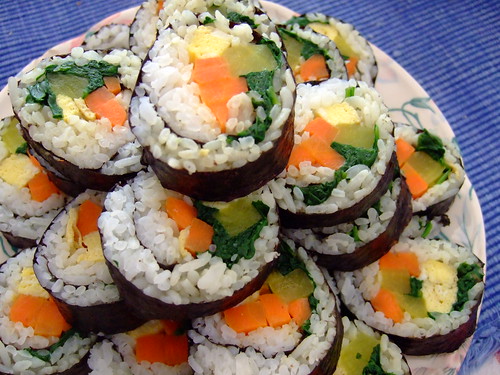1.I have been too lazy, and
2.I have actually been busy
Well, last week I was going to write up a post on gimbap because I had it last week. And to make up for not posting last week I will post something today and also something tomorrow.
So today’s post is going to make up for last week, so the post is still going to be about gimbap. Now have you ever tried gimbap before? For those of you who have not tried it before, let me ask you another question. Have you ever tried sushi before? If you answered yes to sushi, then let me tell you, gimbap is really just the Korean version of sushi.
Gimbap often comes with cucumber, egg, danmuji (pickled radish), carrot and anything really. The name derives from, bap which is rice and gim which is the name of the dried seaweed which is used to wrap it.
There are many variations of gimbap:
Short grain white rice is usually used, although short-grain brown rice, like olive oil on gim, is now becoming more widespread among the health-conscious. Rarely, sweet rice is mixed in gimbap rice. Nowadays, gimbap's rice is much kind of black rice, boiled rice and cereals etc.
Gim is dried, pressed seaweed made from the edible species, laver. Gim may be roasted and seasoned with oil and salt, roasted but unseasoned, or raw and unseasoned. The oil used for roasting gim is traditionally sesame oil; however, today, corn and canola oils are also commonly used, especially with the pre-seasoned packs of gim sold widely in stores. Olive oil is also becoming more prevalent. For gimbap, the roasted, unseasoned variation is typically used.
Besides the common ingredients listed above, some varieties may include cheese, spicy cooked squid, kimchi, luncheon meat, or spicy tuna. The gim may be brushed with sesame oil or sprinkled with sesame seeds. In a variation, sliced pieces of gimbap may be lightly fried with egg coating.
Samgak gimbap (삼각김밥) is a triangle-shaped gimbap sold in many convenience stores in South Korea. It is derived from Japanese triangle-shaped rice ball "Onigiri" which was introduced in Japanese convenience stores in South Korea in recent years. Samgak gimbap also come in many varieties.
Chungmu gimbap is a unique gimbap made without any ingredients inside the roll. Originating from the seaside city of Chungmu, the rolls are thinner than regular gimbap and the surface is not brushed with sesame oil. Chungmu gimbap is traditionally served with side dishes of kolddugi muchim (꼴뚜기 무침), sliced baby octupus marinated and fermented in a spicy red pepper sauce, and radish kimchi (무김치).
Now, finally for the recipe of gimbap, today I will be telling you how to make a vegetarian version for two people, but feel free to add meat or fish.
Ingredients
•Laver/seaweed 4 sheets
•Steamed rice for 2 people
•4 Yellow radish strips
•3 stalks of spinach
•a carrot
•a cucumber
•6 long sticks of seasoned edible burdock root
•3 eggs
•Some sesame oil and sesame
•Some salt
Preparation (It will take about 15 minutes)
1.Cut the carrots and cucumber into long thin slices. (you need 6 sticks.)
2.Rinse the spinach and parboil it in boiled water. (For 1 minute)
3.Put the spinach into a bowl. Add 2 sprinkles of salt and 1 dash of sesame oil on spinach then mix it well.
4.Beat one egg in a bowl. Fry the egg in a pan and make the egg stick by rolling it. (It is better if you can make it thin.) Do the same with rest of the eggs.
5.Cook the carrots, crab sticks and BBQ ham in a pan with a little oil. (You can use un-cooked ones, but I prefer cooked ones.)
6.Put all the ingredients on one plate. It makes it easy to roll.
7.Add 2 dashes of sesame oil and 2 sprinkles of salt on the rice. Mix it well.
Making (It will take about 10 minutes)
1.Place one sheet of seaweed on a flat surface.
2.Put the rice on the seaweed and spread it thinly.
3.Put two burdock sticks, two carrot sticks, two cucumber sticks, crab stick, ham, yellow radish, egg stick (all one each), and some spinach in the middle of the rice.
4.Roll it. (If the seaweed doesn’t stick, paste some water at the edge)
5.Once you made rolls, paste some sesame oil and sesame onto the seaweed’s surface (just little bit) and slice them.
6.Serve it on the plate.

And there you have it, my simple version of gimbap which is yummy and easy to make. Perfect for the weather now, not too hot and not too cold.
Tomorrow I'll come back with some more recipes, I think I will stick to the theme of Korean for a bit longer, so stay in tune.
BYEE
No comments:
Post a Comment